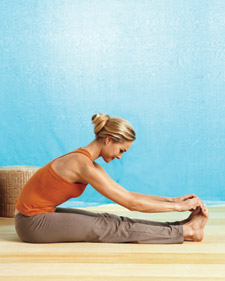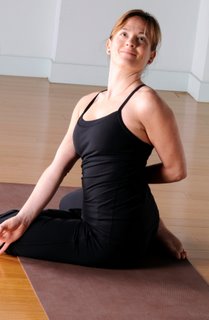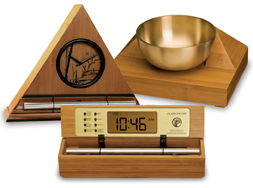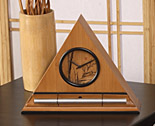|
 Secure Site
Secure Site
|
 |
Archive for the 'Chime Alarm Clocks' Category
 yoga A harmonizing practice for people in recovery
lwKnee-Hug Spinal Twist Jathara Parivartanasana
Benefits Releases the lower back and lengthens the spine. Increases flexibility of the spine, back, and ribs.
Affirmation Everywhere I turn I see beauty.
Lie on your back and hug your knees into your chest. Keep your knees bent into your chest and place your arms out to your sides. Your palms can be up or down, whichever feels most comfortable to you. Inhale. As you exhale, move your hips and knees to the left as you turn your head to the right. Hold the position and breathe. When you are ready, do a gentle spinal twist to the other side.
adapted from Yoga Journal by Annalisa Cunningham, author of Healing Addiction with Yoga
Posted in Chime Alarm Clocks, yoga, Yoga Timer, Yoga Timers by Now & Zen
 yoga practice A harmonizing practice for people in recovery
As you practice the following sequence, remember to honor your limitations, going to your edge with love and acceptance rather than judgment and discouragement. If you are unable to move into a posture at this time, focus on breath-ing deeply as you think about the affirmation—that in itself is healing. At the end of the routine, take some time to write down your thoughts.
Benefits Releases the lower back and lengthens the spine.
Affirmation I hold myself with compassion.
Lie on your back and bring your knees in toward your chest. Wrap your arms around your knees and legs, hugging them toward you. Keep your chin slightly tucked so your neck stays long on the floor.
Hold the position and breathe.
adapted from Yoga Journal by Annalisa Cunningham, author of Healing Addiction with Yoga
 Bamboo Zen Clocks and Chime Timers, a Natural Sound Alarm Clock Now & Zen
1638 Pearl Street
Boulder, CO 80302
(800) 779-6383
Posted in Chime Alarm Clocks, yoga, Yoga Timer, Yoga Timers by Now & Zen
 seated forward bend A harmonizing practice for people in recovery
As you practice the following sequence, remember to honor your limitations, going to your edge with love and acceptance rather than judgment and discouragement. If you are unable to move into a posture at this time, focus on breath-ing deeply as you think about the affirmation—that in itself is healing. At the end of the routine, take some time to write down your thoughts.
Benefits Helps stretch the hamstrings and lower back. It also fosters a sense of calm and letting go, while gently stretching the spine.
Affirmation I move forward with patience.
Sit on the floor with your legs extended in front of you. Sit up straight and rotate your ankles, flexing and stretching them. Keeping your feet flexed, inhale and lift your arms above your head. As you exhale, bend at the hips and lower your chest toward your knees. Keep your spine straight as you do this. Place your hands on your calves, ankles, or feet, wherever you can comfortably reach. Hold the pose for 10 breaths.
adapted from Yoga Journal, by Annalisa Cunningham, author of Healing Addiction with Yoga
 Zen Alarm Clock with Gentle Chime for Stress Reduction Now & Zen
1638 Pearl Street
Boulder, CO 80302
(800) 779-6383
Posted in Chime Alarm Clocks, mindfulness practice, Well-being, yoga, Yoga Timer, Yoga Timers by Now & Zen
 harobu Christy Porter spends her days hefting crates and picking cantaloupe to feed migrant farmworker families in Southern California’s Coachella Valley. It’s hard work, and it shows. The 48-year-old nonprofit director walks with a seesaw gait on arthritic and overtaxed knees. Her arms are dotted with spider bites, her legs often splashed with oil from do-it-yourself attempts to fix the forklift.
Yet despite the dings, Porter seems to glide on a cushion of air. Like one of those airboats skimming over crocodile-infested waters in the Everglades, she rides a little higher than those around her. Her cushion? Not a daily meditation practice or a stress-busting supplement, but poetry. In her mind’s eye, its images and rhythms transform her everyday surroundings into something new and fresh.
Sure, it’s 120 degrees outside, but isn’t that brutal glare simply the world blazing, “like shining from shook foil,” as Gerard Manley Hopkins said?
And yes, she occasionally runs into sidewinders lurking under the warehouse stairs. But it’s hard to be spooked when she thinks of Emily Dickinson’s “narrow fellow in the grass.” “You know that starburst filter that photographers use to make everything sparkle?” Porter asks, shaking her blonde hair out of a big straw hat. “Poetry is like that to me.”
Indeed, healers through the ages have turned to poetry for its remarkable ability to soothe and console, much like prayer and song. The Iroquois fought off depression after the loss of a loved one by chanting a condolence incantation. In ancient Egypt, healing verses were written on papyrus which was then dissolved into a brew to be sipped.
Today, poetry is actually making its way into some doctors’ offices. Harvard poet-physician Rafael Campo, author of The Healing Art: A Doctor’s Black Bag of Poetry, is convinced that reading, writing, or reciting poetry can be therapeutic. In his own internal medicine practice, he likes to slip sheets of poetry among the prescriptions and brochures he hands out to patients.
Campo believes poetry can let people see illness differently (the starburst lens theory), as well as help them stay on an even keel amid life’s spider bites and forklift breakdowns.
While he’s certain that poetry is good for people, he can’t tell you quite why. “We’re just at the early stages of understanding the possible mechanisms of action,” Campo says. “But poetry probably affects people beginning on the level of the neurons in the brain stem. When patients read or recite poetry, the rhythms have been shown to improve the regularity of their heart and breathing rates.” Indeed, a study published in the International Journal of Cardiology showed that when volunteers read poetry aloud for 30 minutes, their pulse rates were slower than those of people in a control group who engaged in conversation.
Getting Acquainted with Poetry
For most of us, poems are something we left behind in high school or college. Here are a few simple ways to bring them back into your life.
• Go back to the beginning Try to remember something, anything, you liked that was read to you as a child: Mother Goose, Shel Silverstein, hymns or lullabies. The rhythms that moved you as a child can reach you now, and serve as your entrée to more adult fare.
• Read with your ears Poetry reaches us through our ears even more than our eyes. To experience this aural impact, go to a poetry reading or listen to tapes or CDs of poets reading their work. Or, as Denise Levertov once suggested, go into the bathroom and read poems out loud to yourself.
• Find your match “There’s a poem for everybody just like there’s music for everybody,” Christy Porter says. Don’t give up because you hate Hopkins or loathe Levertov. If intricate language is not your thing, try a plain-speaking poet like Mary Oliver or Billy Collins, the former U.S. poet laureate.
• Learn one by heart There’s nothing as handy as a great poem that’s filed in your brain, always accessible. Use relaxed moments when you’re walking or hiking to memorize a poem or lines from a poem. Poems learned by heart are “secret talismans,” Rafael Campo says. They can “ward off panic attacks while you’re flying on a plane—or be recited aloud while you’re doing yoga in the living room.”
• Write your own You don’t have to write poetry to benefit from the art form, but if you’re moved to try your hand at it, Campo recommends these guides: John Fox’s Poetic Medicine: The Healing Art of Poem-Making (J.P. Tarcher, 1997) and Louise DeSalvo’s Writing as a Way of Healing (Beacon Press, 2000).
adapted from Natural Solutions, by Anna Japenga, January 2004
 Zen Alarm Clock for a Gentle Awakening Now & Zen
1638 Pearl Street
Boulder, CO 80302
(800) 779-6383
Posted in Chime Alarm Clocks, Dreams
 yoga There is one yogic breathing technique that can be practiced at all times of the day and night by just about anyone. This pranayama (breath control) is called ujjayi.
Ujjayi means “victorious.” The prefix ud means upward and superior, and jaya (from root ji) means to conquer and have victory over. With consistent practice of ujjayi breath, a practitioner will attain victorious results for both body and mind.
The benefits of ujjayi breath are manifold. In addition to aerating the lungs and removing excess phlegm, it boosts endurance and gently warms the body. This soothing breath massages and tones the entire nervous system, making it an excellent way to combat stress. It’s also believed to help counter high blood pressure.
While one should initially learn ujjayi breath in a seated position, in can later be consistently threaded through the entire asana practice.
Here’s how to practice:
1. Sit in a comfortable, upright meditation position (I encourage sitting on a folded blanket or pillow for extra support)
2. Maintaining a tall spine, close eyes and begin to breath normally through both nostrils. Observe the flow of the air in and out of the body.
3. Once you’re familiar with the course of the breath, take a deep, slow breath in through the nostrils. Try to focus the air in on the palate and back of the throat and create a sibilant sound (saaaa). It should be an ocean like sound, or like having your ear against a conch shell. Fill the lungs entirely and then…
4. Breath out slowly, focusing the air on the back of the throat/palate.
The sea-like sound is caused by a subtle constriction of the glottis, which is the aperture of the larynx.
The breath should be just loud enough that someone sitting close to you would hear it. Avoid being too loud of forceful. I’m fond of esteemed Ashtanga teacher Tim Miller’s description of ujjayi, “Imagine sipping the breath in through a straw. If the suction is too strong the straw collapses and great force is required to suck anything through it.”
5. Set your Zen Timer with Tibetan Bowl for 15 minutes. Continue to breathe for 5 to 15 minutes with this ocean like sound. If possible, take a brief savasana after.
More experienced practitioners, commit to carrying ujjayi breath through your entire asana practice. Let it be metronomic in quality.
Observe how much space you’ll discover in body and mind!
Sophie Herbert is an alignment focused yoga teacher (and perpetual student), a singer-songwriter, and a visual artist. She has lived, studied, and volunteered extensively in India; teaches yoga in Brooklyn and Manhattan; and recently released her first full-length album, “Take a Clear Look.” Please visit her website at SophieHerbert.com.
adapted from Wholeliving.com February 2011
Use our unique “Zen Clock” which functions as a Yoga Timer. It features a long-resonating acoustic chime that brings your meditation or yoga session to a gradual close, preserving the environment of stillness while also acting as an effective time signal. Our Yoga Timer & Clock can be programmed to chime at the end of the meditation or yoga session or periodically throughout the session as a kind of sonic yantra. The beauty and functionality of the Zen Clock/Timer makes it a meditation tool that can actually help you “make time” for meditation in your life. Bring yourself back to balance.
 The Zen Timer and Clock Store - Boulder, Colorado Now & Zen – The Zen Timer Store
1638 Pearl Street
Boulder, CO 80302
(800) 779-6383
Posted in Chime Alarm Clocks, yoga, Yoga Timer, Yoga Timers by Now & Zen, zen, Zen Alarm Clock, Zen Clocks and Dream Recall, Zen Timers
 meditation under tree A good example of body-mind-body medicine is the work of Jon Kabat-Zinn, Ph.D., founder of the Stress Reduction Clinic at the University of Massachusetts Medical School and author of the bestsellers Full Catastrophe Living and Wherever You Go, There You Are. His Mindfulness-Based Stress Reduction (MBSR) approach, which combines gentle hatha yoga with mindfulness meditation, has garnered impressive results in scientific studies and is now taught at hundreds of hospitals and clinics worldwide.
In his work with patients with a wide variety of medical conditions, including chronic pain, cancer, arthritis, anxiety, and depression, Kabat-Zinn has observed that particular patients seem to respond better to some elements of the MBSR program. He has found that those with primarily physical complaints, such as joint pain, often do best when they use meditation to go through what he calls the “mind door.” Others, particularly those with mental problems such as anxiety or panic attacks, may do better with “body door” approaches like asana.
adapted from Yoga Journal by Timothy McCall, M.D.
Use our unique “Zen Clock” which functions as a Yoga Timer. It features a long-resonating acoustic chime that brings your meditation or yoga session to a gradual close, preserving the environment of stillness while also acting as an effective time signal. Our Yoga Timer & Clock can be programmed to chime at the end of the meditation or yoga session or periodically throughout the session as a kind of sonic yantra. The beauty and functionality of the Zen Clock/Timer makes it a meditation tool that can actually help you “make time” for meditation in your life. Bring yourself back to balance.
 Gentle wake up alarm clock by Now & Zen Now & Zen – The Zen Alarm Clock & Timer Store
1638 Pearl Street
Boulder, CO 80302
(800) 779-6383
Posted in Chime Alarm Clocks, intention, Meditation Timers, Meditation Tools, mindfulness practice, Natural Awakening, Now & Zen Alarm Clocks, wake up alarm clock, yoga, Yoga Timer
 how to say no You caved — again. Now you’re stuck chairing the annual fund-raiser (or cat-sitting for your neighbor, or working late). What if you could turn down that request, that offer, that invite, and not feel so guilty about it afterward? Wouldn’t it be great if once, just once, you could stick to your guns and say no when you needed to most?
There are lots of reasons we struggle with “no.” Some feel bound by obligation or by fear of hurting someone’s feelings. Others believe they really can do it all (and hate to pass up the opportunity to try). But think about it: Almost every misplaced yes is really a no to yourself.
“When you can’t say no,” says negotiator William Ury, Ph.D., author of “The Power of a Positive No,” “you give up what’s essential to you in favor of what other people want.” You also put yourself on a fast track to a meltdown. “When you take on more than you can handle, you eventually burn out,” says Nanette Gartrell, M.D., author of My Answer Is No … If That’s Okay with You. “It’s not uncommon to develop exhaustion or even depression as a result.”
By asserting yourself in a considerate, confident way, says Ury, you can be selective about what you take on without jeopardizing friendships — a people-pleaser’s biggest fear. Try our five-step plan so that you can start saying no — and stop feeling guilty.
Five Steps to Saying No
1. Find Your Yes
Before you can even think about getting good at saying no, get clear on what to say yes to in life. If your yes is more time with your family, that will mean turning down obligations that keep you away from home. If it’s yes to better health, you’ll need to say no to late nights at work that keep you from the gym. The firmer your foundation and connection to your yes, says Ury, the less difficult it will be to say no. After all, you’ll be answering to a higher cause.
2. Buy Some Time
Whenever possible, don’t respond to a request on the spot. This keeps you from saying yes under pressure (“Um … sure I’ll host the baby shower”) or reacting emotionally to the request, especially when you’re feeling stressed out. “We can’t say no without getting a firm grip on our natural reactions and emotions,” says Ury — and that won’t happen unless you’ve taken the time to collect your thoughts.
To gain some perspective, Ury suggests getting some distance from the issue at hand physically and mentally for a few hours, or even a day. Figure out whose interests are at stake, what’s really being asked of you, and whether it makes sense to say yes. But be sure not to wait too long; leave the person hanging indefinitely, and you could damage a relationship.
3. Deliver Your No with Grace and Resolve
The moment of truth can be the most difficult of all, particularly when you’re afraid of hurting someone’s feelings. Ury suggests a “yes-no-yes” approach: First, share what you’re currently saying yes to (“My mother and I always go out for breakfast on Saturday mornings”). Then say no (“So I won’t be able to help you set up for the brunch you’re hosting”).
But don’t stop there. After you’ve turned someone down, affirm your good intentions by closing with another yes — this time, to a mutually positive outcome (“But I’d be happy to help clean up after it’s over”). In so doing, you relieve some of the frustration wrought by closing a door, while sending the message that you respect the other person’s needs.
For greater requests of your time — say, to serve on the town board or help a colleague launch her new business — be direct and to the point: You’re flattered but have decided to devote any free time to your children’s school instead. Avoid burdening the other person with unnecessary or elaborate excuses (such as how your mother moved away and can’t watch the kids). You run the risk of the other person trying to fix the situation (“Bring the kids, then!”). Plus, the more drawn-out the excuse, the less authentic it sounds — and, in the end, it’s really no one else’s business.
4. Have a Plan B
Even if the other person gets emotional or reactive after you’ve delivered your no, don’t yield under pressure — as difficult as this may seem. Instead, take a deep breath and listen attentively to his or her objections. Then, gently but firmly, underscore your no — and keep it simple and clean; no backpedaling or scrambling for defense.
What if your no is met with extreme resistance? Your in-laws insist that you spend the holidays at their home again; a colleague plays hardball in pressuring you into taking over a project. For this, Ury proposes having a Plan B. Think about what’s at stake (your time, resources, or respect) and be ready to pursue another path if your original no goes unheeded.
If your no fails to convince a pushy coworker that you can’t take on extra projects, for instance, plan to bring the conversation to a close and go to your boss with your concerns if necessary. If your sister has a habit of dropping the kids off unannounced (despite your protests that you have other pressing obligations), decide that next time she ignores your no, you will respectfully tell her you already have plans — and then leave the house. “The key here is not necessarily to leap to Plan B,” says Ury, “but to have it in mind so that, going in, you know you have alternatives.”
Note that while Plan B works wonders when it comes to isolated situations, it can also be incredibly helpful in addressing general patterns you fall into. Your Achilles’ heel might be lending money to friends and family (and forgetting to get repaid) or going weak when the nonprofit solicitors come knocking. Recognize these tendencies, and you’ll be more effective in lining up your own backup plan.
5. Cut Yourself Some Slack
Even with practice, some will always find saying no a challenge. For the dyed-in-the-wool people pleaser, there may be a twinge of guilt — and, for the overly ambitious, regret. Realize that your perennial inclination to offer help is something to be lauded, not criticized. “Be proud of the qualities that make it so hard to say no — thoughtfulness, empathy, compassion, generosity,” says Gartrell. “Without them, the infrastructure of our society would collapse.” Just bear in mind that by balancing your “pleaser” and “doer” tendencies with a commitment to your values, you’ll be stronger for it. Even better, you’ll be a more focused contributor to the people and things that matter most to you.
How to Say No
There’s more than one way to say it. Skip the excuses and opt for one of these suggestions from author William Ury.
“Not now.” This softens the blow and keeps the door open for another time.
“I have another commitment.” No other excuse required; you honor your commitments.
“Maybe I can help you find someone who can.” This shows respect and concern.
“I have a personal policy about …” And fill in the blank. By saying this, you put the focus on a prior commitment to yourself without opening the door for an argument (useful, say, when someone wants you to commit to working on Saturdays or give to a charity when you have a different one in mind).
“I don’t want to take on what I can’t fully commit to doing well.” This is a yes to higher standards.
adapted from Body + Soul, March 2008
 - Bamboo Zen Clock
Now & Zen
1638 Pearl Street
Boulder, CO 80302
(800) 779-6383
Posted in Chime Alarm Clocks, intention, Meditation Tools, Natural Awakening
 pamper your feet Cold feet are one of winter’s most annoying — and common — afflictions. The answer? A rich blend of warm, wintry spices. Cayenne, cinnamon, and ginger are all circulation boosters and mild stimulants. Applied topically, they increase blood flow, relieving chill and numbness. Cayenne, in particular, has foot-warming benefits; folk wisdom suggests sprinkling the fiery pepper into socks on cold days. For a more luxurious experience, try this simple foot mask. It combines spices, skin-soothing ingredients such as oatmeal and honey, and the invigorating essence of orange.
Orange Spice Foot Mask
 cure cold feet 1/2 cup whole oats
1/2 teaspoon cinnamon
1/2 teaspoon cayenne pepper
4 tablespoons warm water
1 teaspoon olive oil
1 tablespoon honey
1 tablespoon fresh ginger, grated
4 drops sweet orange essential oil
Food Mask How-To
1. Using a food processor, grind the oats to a fine powder. Transfer to a medium-size bowl, add the remaining ingredients, and stir until blended into a thick paste.
2. Prepare two warm, wet washcloths or hand towels, either by wetting them and placing them in the microwave for one to two minutes or by soaking them in hot (not boiling) water. Wring out excess water and set aside.
3. Sitting with your feet in the tub or a large basin, use your hands to spread a thick layer of the mask over each foot, covering them completely up to the ankles. After wiping hands clean, wrap each foot in one of the washcloths to seal in the moisture from the mask. Set your Zen Timer for 15 minutes. Set your Zen Timer with Bowl. Sit back and relax for 10 to 15 minutes.
4. When you’re ready to remove the mask, carefully lift off the washcloths. Rinse your feet thoroughly using warm water. Pat dry with a towel.
adapted from Body + Soul Magazine, Jan/Feb 2006 by Donna Garlough
 Zen Alarm Clock with Maple Leaves Now & Zen
1638 Pearl Street
Boulder, CO 80302
800) 779-6383
Posted in Chime Alarm Clocks, Well-being, Zen Alarm Clock, Zen Timers
 do it yourself facial Massaging Your Face
This is a great way to loosen muscles scrunched into habitual expressions. “This brings blood to the surface, clears out puffiness, and reduces fatigue in the skin,” says Chris Haas, owner of Ra Organic Spa in Burbank, California. Don’t have time for an appointment? At home, all you need is the following ingredients for a facial serum. Barbara Close, founder of Naturopathica, recommends a base of evening primrose and avocado oils with rose geranium, lavender, and German chamomile essential oils for dry skin, or apricot kernel oil with juniper, lemon, and rosemary oils for oily skin. How? Starting at the chin, move your hands in small circles and continue to the cheeks, around the eyes, and to the forehead. By doing this, you’re stimulating circulation and bringing more nutrients to the skin. Follow with a warm compress to increase the absorption of the serum. Here are some DIY recipes for facial serum, based on your type of skin:
For Dry Skin
Ingredients
1-ounce bottle
1/2 ounce avocado oil
1/2 ounce evening primrose oil
6 drops rose geranium essential oil
3 drops lavender essential oil
2 drops German chamomile
Directions
Fill bottle halfway with avocado oil. Add essential oils, cap bottle, and shake well. Top off with half ounce of evening primrose oil and shake again.
For Oily Skin
Ingredients
1-ounce bottle
1/2 ounce apricot oil
1/2 ounce hazelnut or jojoba oil
6 drops rosemary essential oil
3 drops juniper essential oil
4 drops neroli essential oil
Directions
Fill bottle halfway with apricot oil. Add essential oils, cap bottle, and shake well. Top off with half ounce of hazelnut or jojoba oil and shake again.
For Sensitive Skin
Ingredients
1-ounce bottle
1/2 ounce jojoba oil
1/2 ounce rosehip seed oil
3 drops everlasting essential oil
2 drops German chamomile
6 drops rose geranium essential oil
Directions
Fill bottle halfway with jojoba oil. Add essential oils, cap bottle, and shake well. Top off with half ounce of rosehip seed oil and shake again.
adapted from Body + Soul, October 2010
 Chime Timers and Clocks with Chime in Bamboo, Walnut, Maple, and Black Lacquer Now & Zen
1638 Pearl Street
Boulder, CO 80302
(800) 779-6383
Posted in Chime Alarm Clocks, intention, mindfulness practice, Well-being, Zen Alarm Clock, Zen Timers
 Stress Cures From traffic jams to lost luggage, holiday travel can leave you frazzled. This year, get the holidays off to a stress-free start by arriving at your final destination composed and energized. Just follow these simple tips from Kate Hanley, author of The Anywhere, Anytime Chill Guide.
Stretch It Out
Where stress starts, tight muscles follow. Ease the strain of hours sitting in the sky or on the road with a simple, seated stretch Hanley calls The Number Four: Place an ankle over the opposite knee (making the shape of a four) then lean forward and rest your elbows on your shin.
Apply Pressure
If icy roads or midflight turbulence leave you with a pounding heart and racing thoughts, Hanley recommends a little acupressure. Simply curl each finger down until it touches the palm. The subtle move lessens anxiety by slowing down the heart and, in turn, quieting the mind.
Say It Out Loud
“The very act of traveling requires an element of surrender,” says Hanley. When plans go awry (a delayed flight, a missed exit) — and they will — slowly repeat the mantra “I’ll get there when I get there.” This helps you stay mindful of what’s out of your control.
Wish Them Well
With everyone rushing to get from point A to point B, you’re guaranteed to run in to someone who will ruffle your feathers. “The trick to not losing your cool,” says Hanley, “is to develop compassion.” Instead of flying off the handle at that impatient driver or curt customer service rep, try a kindness meditation. Hold an image of them in your mind and put yourself in their shoes with an empathetic thought: “I’m sure he’s anxious to see his family” or “I bet she’s had a long day.”
adapted from Body + Soul November 2009
 Zen Timer for your wellbeing practice Now & Zen
1638 Pearl Street
Boulder, CO 80302
(800) 779-6383
Posted in Chime Alarm Clocks, intention, Meditation Timers, Meditation Tools, mindfulness practice, Now & Zen Alarm Clocks, Well-being, Zen Timers
« Previous Page — « Previous Entries
Next Entries » — Next Page »
|
|
|
|